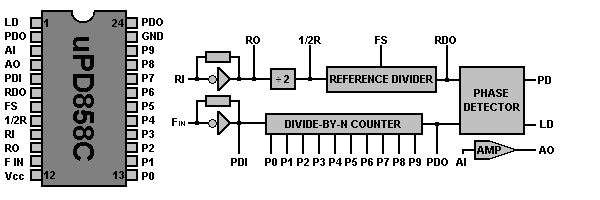  Main Other useful info  Last modified 2020-04-17 |
uPD858CPLL frequency synthesizer
OverviewDown-converting of the frequency to the divider The XTAL frequency is f XTAL = f OUT - f IN
Modification methodsBCD Programming of uPD858
P4 to P7 is TENS P8 to P9 is HUNDREDS Above each program pin number is now something called "BCD POWERs" rather than the previous "POWERS-OF-2". In this system the pins are assigned such that each successive group of pins has a significance 10 times greater than the preceeding group. Within each decimal group the weights still double in the usual binary progression, but here the highest possible number in a group can't exceed "9" or its decimal multiple such as "90", "900", etc. (Assuming there were that many IC pins.) Each decimal group can only have a maximum of 4 bits. In this IC there are only 10 rather than 12 program pins so the Hundreds Group can never be worth more than (1 + 2) x 100 or 300. Just figure the total binary value of each group in the usual way, multiply it by 1, 10, or 100 as appropriate, then add all the groups together: 0nes Group + Tens Group + Hundreds Group, etc. Since each group has a value, the sum of the groups is the N-Code. For Ch.1, the group sum is 1 + (10 + 80) = 91. Try the math yourself for the other channels. Also notice that Pin 22 is permanently grounded (logic "0" ) since its BCD weight is "200", but we never need a code bigger than "135." (100 + 30 + 5.) By using all ten pins (pins 13-22) you see there's a potential frequency capacity of (9 + 90 + 300) = 399 channels if you could .program them all. This fact has been put to great use in modifications! Once again, the uPD858 chip had the excess capacity for possible use elsewhere. See also the explanation of PLL pin functions |
